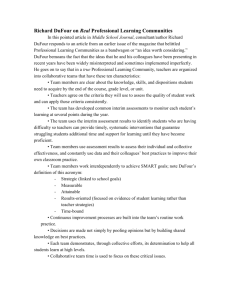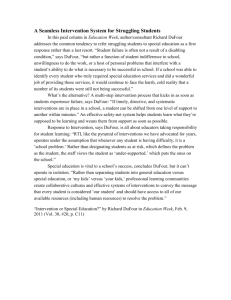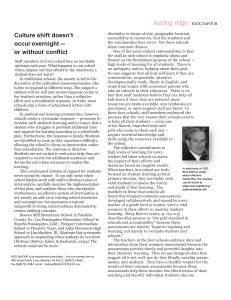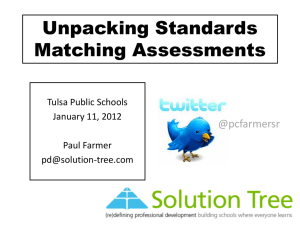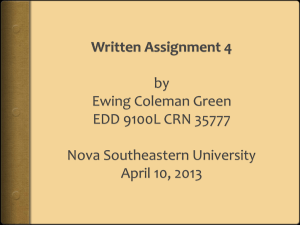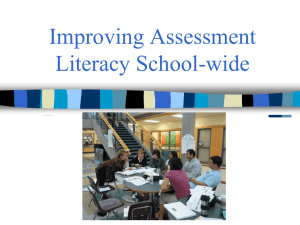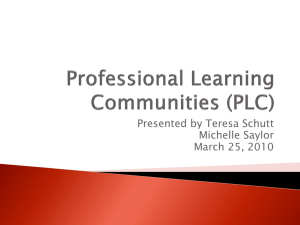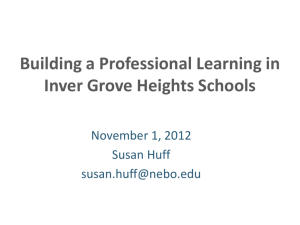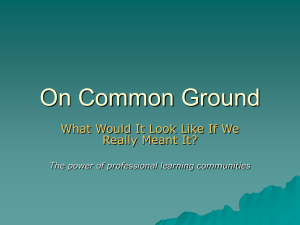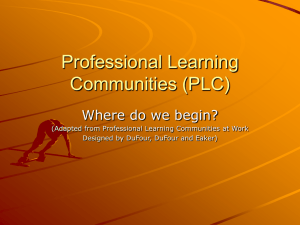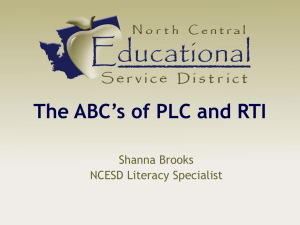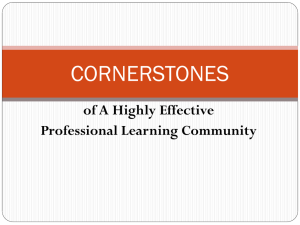Event Power Point
advertisement
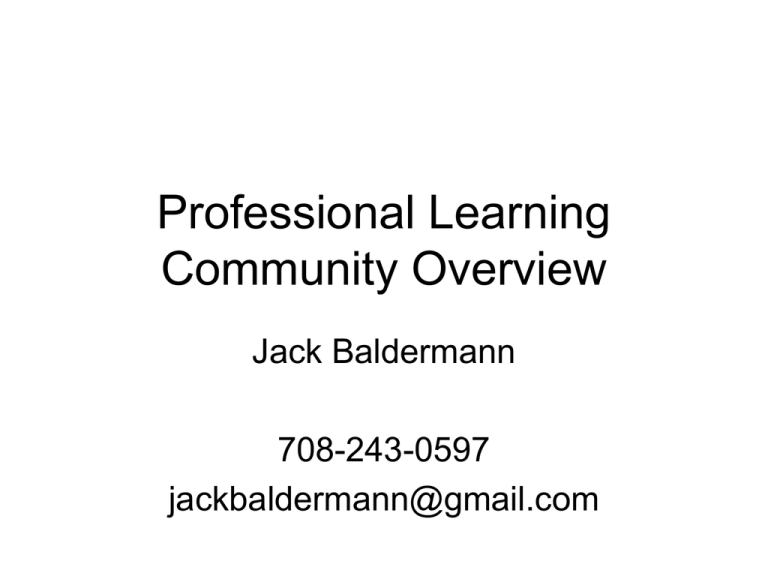
Professional Learning Community Overview Jack Baldermann 708-243-0597 jackbaldermann@gmail.com THE COMMUNITY ENTRUSTS TO US WHAT IS MOST SACRED IN THEIR LIVES. Every Student is a Genius (Armstrong, 1998) • “It may be buried under loads of putdowns, negative evaluations, low grades and test scores, delinquent behavior, self-hatred, and more, but like the seed in winter that lies dormant…only to blossom in the sun’s warmth in spring, this genius too can survive if you will take the time to study the optimum conditions for its growth in the classroom” (p. 48). “This is the team. We’re trying to go to the moon. If you can’t put someone up, please don’t put them down.” - NASA Motto What We Believe and Live-Philosophy “I look for people who are psyched and ready to do whatever it takes. Attitude is about being on fire—you’ve got to approach work like it’s a religious experience.” Charlie Trotter, Lessons in Excellence What We Believe and Live-Philosophy “Excellence is the result of caring more than others think is wise, risking more than others think is safe, dreaming more than others think is practical, and expecting more than others think is possible.” High Expectations for ALL students Riverside Brookfield High School: Results - Accomplishments • One of the Most Improved High Schools in Illinois/Nation • Top 100 – America’s Best High Schools – Newsweek (2006) • “A+” – Highest Rating – School Search, Inc. • “Outperformer” – Highest Rating – Standard & Poor’s • 99% Graduation Rate (2004, 2006) • 100% Graduation Rate for Hispanic & African American students (represent 17% of population) (2006) • Rated “10 out of 10” – Great Schools Continuous Improvement “Good is the enemy of great.” Jim Collins Good to Great “No matter how much you have achieved, you will always be merely good relative to what you can become. Greatness is an inherently dynamic process, not an end point. The moment you think of yourself as great, your slide toward mediocrity will have already begun.” Jim Collins Outcomes • To gain a better understanding of what a professional learning community is and how it works. • To emphasize the importance of collaboration in order to maximize student achievement. What are our schools’ strengths? What is a Professional Learning Community? Three Big Ideas • Learning for All – Learning as the constant, time and support as the variable • A Culture of Collaboration – “A systematic process in which we work together, interdependently, to analyze and impact professional practice in order to improve our individual and collective results.” -DuFour, DuFour & Eaker • Focus on Results Why PLC? “The most promising strategy for sustained, substantive school improvement is building the capacity of school personnel to function as a professional learning community. The path to change in the classroom lies within and through professional learning communities.” -Milbrey McLaughlin Four Critical Questions 1. What is it we expect kids to learn? 2. How will we know when they have learned it? 3. How will we respond when they don’t learn? 4. How will we respond when they already know it? Implementing the PLC Model • Teaching vs. Learning • Shared Mission, Vision, & Values • S.M.A.R.T. Goals • Collaborative Teams • Establish Essential Outcomes • Create Common Assessments • Examine Student Data to Improve Instruction • Commitment to Continuous Improvement • Results Orientation Teaching vs. Learning Focus on Learning “Whereas many schools operate as if their primary purpose is to ensure that children are taught, PLCs are dedicated to the idea that their organization exists to ensure that all students learn essential knowledge, skills, and dispositions.” DuFour, Robert Eaker & Thomas Many; Learning by Doing “Rather than improving students, the business of the school becomes improving the educational experiences provided to students.” - Phillip C. Schlechty, Shaking Up the Schoolhouse, 2001 Shared Mission, Vision, & Values Mission, Vision & Values “It is impossible to develop a results orientation unless we are clear about the core of the enterprise (mission), about the kind of school we’re seeking to become (vision), and the attitudes, behaviors and commitments we need to promote, protect and defend (values).” DuFour & Eaker A PLC’s Mission and Vision Must… – FOCUS ON LEARNING – EMPHASIZE A COLLABORATIVE CULTURE – HOLD HIGH EXPECTATIONS FOR ALL STUDENTS – FOCUS ON RESULTS AND BE COMMITED TO CONTINUOUS IMPROVEMENT S.M.A.R.T. Goals S.M.A.R.T. Goals Specific Measurable Attainable Realistic Timely “Replace the voluminous strategic planning process with a few very specific goals.” -Learning by Doing Dufour, et. al. Page 120 Goals • Results by Mike Schmoker • Big Hairy Audacious Goals B.H.A.G.S. – Jim Collins • The Carrot Principle – Gostick and Elton • School Goal Setting Rick Dufour McREL’s meta-analysis of 27 studies on successful school leadership found: • Set “non-negotiable” goals for achievement • Involve others in setting these goals • Continually monitor progress and make corrections as needed • Focus resources, especially for training, on district-wide goals Robert Marzano & J. Timothy Waters Why Goals? The Power of Goals • Provides Focus • Sense of Accomplishment for Teachers/Students • Pride • For each class, we will work to maintain a graduation rate of 95% or higher Strongly Support-82 Support-24 Disagree-1 Strongly Disagree-0 • To increase academic achievement as measured by the PSAE/ACT so our students’ scores continuously improve and rank in the top 5% or higher of high school districts in Illinois Strongly Support-65 Support-38 Disagree-2 Strongly Disagree-1 • To challenge and support all of our students to the best of their ability including building one of the best AP programs in the state and nation and having our school rated as one of the top ten high schools in Illinois using the Newsweek Challenge Index Strongly Support-50 Support-49 Disagree-8 Strongly Disagree-0 • We will continue to implement the Professional Learning Community Model including collaboratively developing common assessments and reviewing student performance data to improve curriculum and instruction Strongly Support-64 Support-28 Disagree-0 Strongly Disagree-0 More info-15 Collaborative Teams Collaborative Culture “Creating a collaborative culture is the single most important factor for successful school improvement initiatives and the first order of business for those seeking to enhance the effectiveness of their schools.” Eastwood & Lewis Collaborative Culture • Advantages for Teachers – Gains in student achievement – Higher quality solutions to problems – Increased confidence among all staff – Ability to support strengths and accommodate weaknesses – Ability to test new ideas – More support for new teachers – Expanded pool of ideas, materials, methods Judith Warren Little Tips for Team Norms • Each team establishes its own norms • Norms are stated as commitments to act or behave in certain ways • Norms are reviewed at the beginning and end of each meeting until internalized Sample – Norms for Team Meetings • Be honest and share what you think and feel • Participate in the conversation. It is your responsibility to get your voice in the room. • Focus on the task. • Think creatively and comprehensively. • Treat each other as equals. • Listen to and understand one another’s viewpoints. • Ensure equal time for all participants. Sample Purposes and Non-Purposes • Purpose – to share best practice • Non – to compete or out-do each other • Purpose – to identify criteria for solving a problem and /or to brainstorm solutions • Non – Shame or blame others for the problem. • Purpose – to collaboratively raise reading scores for 11th grade students. • Non – plan and schedule field trips Collaborative Culture “In a PLC, collaboration represents a systematic process in which teachers work together interdependently in order to impact their classroom practice in ways that will lead to better results for their students, for their team, and for their school.” www.allthingsplc.info/ Isolation Collaboration “It should be evident that schools will never realize the fundamental purpose of helping all students achieve at high levels if the educators within them work in isolation.” DuFour et al., Whatever It Takes, 2004. p. 60 Isolation Collaboration “Schools can guarantee all students have access to the same essential outcomes only when the teachers… work together to clarify and commit to those outcomes.” DuFour et al., Whatever It Takes, 2004. p. 60 Collaborative Culture Effectiveness = Focus on STUDENT LEARNING Pyramid of Interventions Special Education Placement Case Study Evaluation Child Review Team Mentor Program Placement Guided Study Program Student Assistance Team Referral SST and Teacher Conference with Parent Social Work Contact/Peer Mediation Student Placement on Weekly Progress Reports Counselor Conference with Student and Parent Good Friend Program Counselor Phone Calls to Parents Counselor Meeting with Student Counselor Watch/Survival Skills for High School Freshman Advisory/Freshman Mentor Program DuFour et al., Whatever It Takes, 2004. p. 210 Riverside Brookfield High School Response to Interventions (RtI) Strategies Individualized Strategies Administrative Teaming, Alternative Placement, Alternative Schedule, Behavior/Academic Contracts, Classroom Observation, IEP, 504 Accommodation Plan, Intervention Teams, Outside Referrals, Progress Monitoring, Records Review, Weekly Progress Reports Targeted Strategies Academic Support, ADA, Ambassador Program, Behavior/Academic Referrals, Blitz, Classroom Profiles, Correspondence Courses, Counselor Watch Program, Drug & Alcohol Counseling, ESL, Executive Functioning Program, Freshman Academic Success Seminar, Learning Resource Center, National Honor Society Tutoring, Parent/Student/Counselor/Teacher Meetings, Parent Support Groups, Progress Monitoring, Read 180, Social Worker Groups, Study Skills Course, Summer School, Credit Recovery, Transition Teams, Truancy Tickets, Zone Program Universal Strategies Before School/After School Help, Articulation with Feeder Schools, CAP, Clubs/Sports/Extra-Curricular Activities, College Planning Workshops and Programs, Common Assessments, Drug/Alcohol Prevention Presentations, Ed-Line, Freshman Orientation, Naviance, Parent/Teacher Conferences, Progress Reports, Universal Freshman Screening, W/F List Establish Essential Outcomes Essential Learning 1. Must be aligned with state standards and district curriculum guides 2. Must ensure students demonstrate proficiency on state, district, and national assessments 3. Must provide timely information and be precise Dufour, DuFour, Eaker, & Many. Learning by Doing, 2006. (pp.46-47) What is Essential? • Do students need to know this to be successful at the next level of schooling? • Do students need to know this to be successful on district, state, and national tests? • Do students need to know this to be successful in life? (relevance) Create Common Assessments Common Assessments • Summative • Infrequent – Specific deadline – “assessment of learning” • Formative – Frequent – Inform teachers regarding effectiveness – Provide for additional time and practice – “assessment for learning” Dufour, DuFour, Eaker, & Many. Learning by Doing, 2006. (p.55) The Research on Formative Assessments • Black and Wiliam – Inside the Black Box • Ahead of the Curve – Reeves, Guskey, Stiggins, Marzano, DuFour et all. • Mindset – Dr. Carol Dweck Fixed vs. Growth Mindset Two Types of Assessments • Assessment of Learning - Did the kid make it to Minneapolis? • Assessment for Learning - Was the kid passing through Kansas City at the time I thought she/he might? - How long did it take him/her to get to Kansas? - At this rate, when do I think s/he’ll reach Minnesota? - Do I need to investigate alternate transportation methods? * What kind of support does the child require to catch up with his/her peers? Common Assessments • More efficient • More equitable • Guarantee common curriculum • Inform the practice of individual teachers • Build capacity to improve • Systematic, collective response to struggling students Dufour, DuFour, Eaker, & Many. Learning by Doing, 2006. (p.57) Examine Student Results to Inform Instruction Examine Student Data • Tests, homework, student products • Protocols to collaboratively study lesson design • Protocols to collaboratively examine student work Examine Student Data • Use feedback on results to inform, not punish. • Provide the basis of comparison that translates data into information. • Use apples-to-apples comparisons. • Use balanced assessments. • Teachers and principals must engage in data analysis rather than outsourcing the task to others. • A fixation with results does not mean inattention to people. Dufour, DuFour, Eaker, & Many. Learning by Doing, 2006. (pp.158-160) Commitment to Continuous Improvement Continuous Improvement “Good is the enemy of great.” Jim Collins Good to Great “No matter how much you have achieved, you will always be merely good relative to what you can become. Greatness is an inherently dynamic process, not an end point. The moment you think of yourself as great, your slide toward mediocrity will have already begun.” Jim Collins Results Orientation Results Orientation • Essential to –Organizational effectiveness –Team effectiveness –Motivation –Continuous improvement Dufour, DuFour, Eaker, & Many. Learning by Doing, 2006. (pp.150-151) Show Me The Data www.allthingsplc.info/ • • School success stories from around the country Tools and resources developed by schools like you On Common Ground DuFour, et al. • Best minds in education agree about PLC
